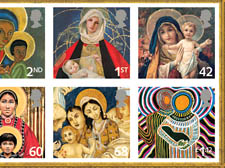|
|
 |
| |
At last, it can be told – the Virgin Mary’s life story
Illtyd Harrington reviews a scholarly biography of the most influential woman in the history of the world
Mother of God: A History of the Virgin Mary. By Miri Rubin. Allen Lane £30.
THE most recognisable and influential woman in Christianity she may be, but her time on Earth is not recorded in much detail. Yet Mary the blessed Virgin, Mother of God, Queen of Heaven, seems to be an active force and the recipient of constant prayers and petitions.
Her mother Anna (God’s granny) and her aunt Elizabeth (mother of John the Baptist) appear, but not too often. For Miri Rubin, like Mary a Jewish woman, is a scintillating scholar and Professor of Medieval and Early Modern History Queen Mary College, University of London, detailing Mary’s first 1600 years.
For centuries argument over her virginal status caused brawling in the streets. Rubin tackles her conception by the Holy Ghost – reporting repeatedly that it could only have been done by the ear. For in spite of having other children, she remained a virgin. The Archangel Gabriel whispers God’s command and that was that. Her husband Joseph, though uneasy, went along with it.
Try as they did, the early Church could not dampen her growing power and status. At times she seemed to be the Margaret Thatcher of heavenly bodies.
Characterised as a gentle woman, she nevertheless took offence easily and rapidly. A German peasant returning from a beer fest doubted the authenticity of her sandal which was on display 12 centuries old. His mouth was quickly distorted and only straightened out when he repented before the sacred footwear. Another fellow who lost at cards in Spain flung them at her open-air shrine. He was soon arrested and, after a summary trial, hanged. The message is: don’t mess with Mary.
The Qur’an mentions her 38 times compared with 19 in the four Gospels.
The three Irish singing priests took the perennial Ave Maria to head Classic FM’s charts for three months.
Religious relics and other sacred objects associated with her became a big industry and her help was constantly invoked by emperors, peasants and princes.
Monastic houses peopled by celibate monks fed the cult of the Divine Mother and wrote the Catholic prayer the Hail Mary and Hail Holy Queen in 1347 and they are still said today.
A monk in Prussia designed the Rosary for praying to her: it remains a powerful religious weapon. In later years, Mary took the opportunity to visit humble people. In the 1850s, it was Bernadette and her phenomenal pilgrimages to Lourdes.
Alarmed by the growth of Communism, she made a series of appearances to people tending their sheep in Fatima. It was 1917, after the rise of Lenin, and she was warning them of a Russian Antichrist.
In one of Mary’s appearances she caused the Sun to rush across the sky in reverse direction. Some 70,000 people witnessed this though few could verify it.
At the sea battle at Lepanto in 1571 with her aid, Christians put to flight the forces of Islam.
Rubin uncovers some delightful examples of her character in English folklore. Did she really pluck a stick from a tree to wallop a 12-year-old Jesus?
She died aged 63 – 16 years after the Crucifixion, and the angels carried her up to heaven from her home in Ephesus. Or was it from Jerusalem? After continuous fierce theological debate, her Immaculate Conception status was authenticated by the Vatican in 1854.
Often invoked in causes of the Right, she was not to be rushed. After the Russian Revolution, messages began arriving in the Vatican about how disturbed she was. Pope Pius XI – a reactionary – then ordered us subservient Catholics to pray for the liberation of Russia from the Red Menace. It took 70 years for the miracle to be achieved when two ex-Communists, Mikhail Gorbachev and Boris Yeltsin, did it for her in 1989. After he became leader, Yeltsin sold Russia’s great assets to the Oligarchs.
Did Mary get it right? This is a superb work, worthy of continuing her life story over the next 500 years from 1600.
Why doesn’t she suddenly appear at the Woman of the Year Award at the Savoy? After all, she’s earned it!
|
 |
|
 |
 |
|
 |
|


